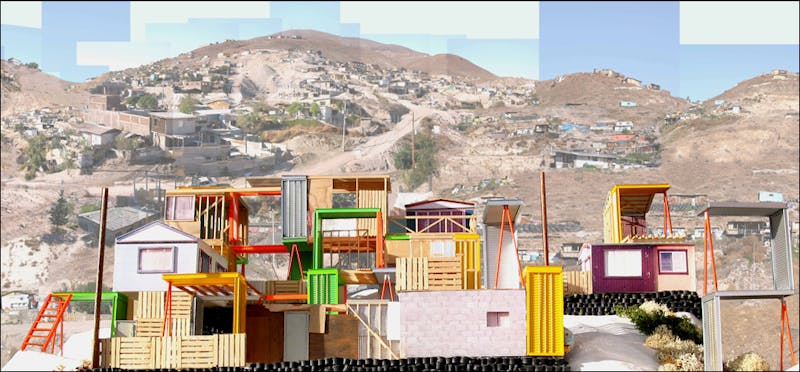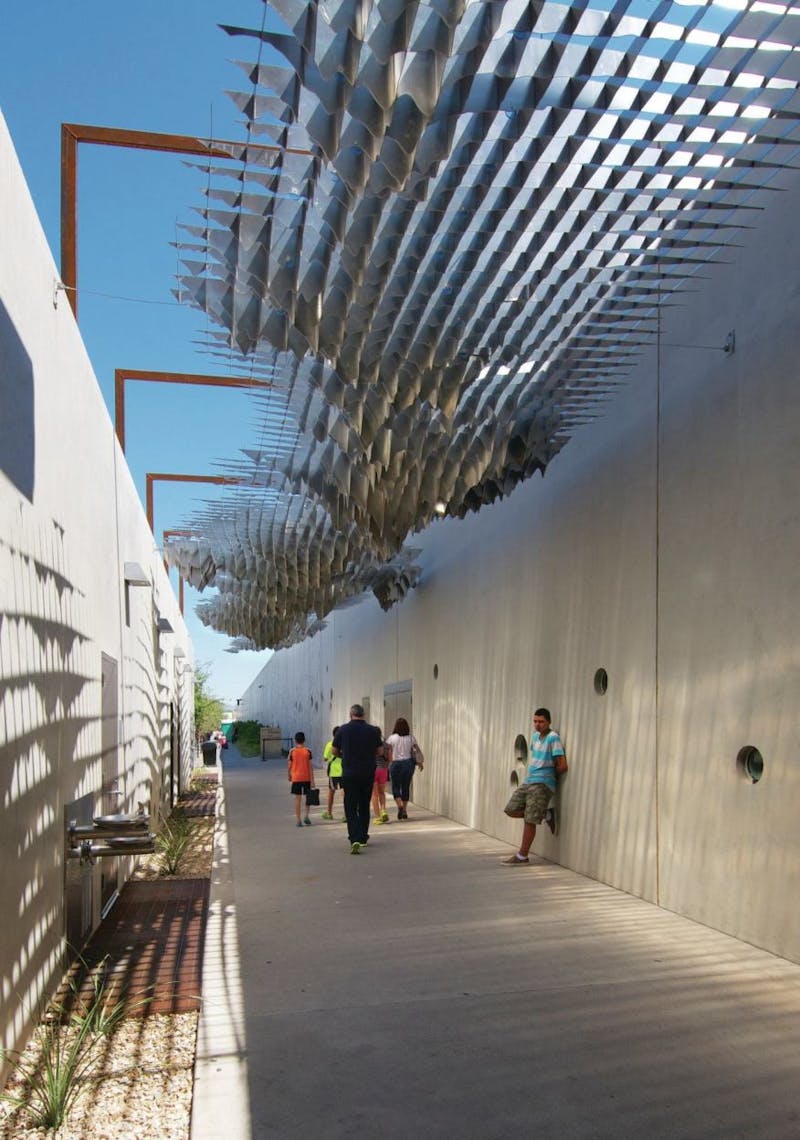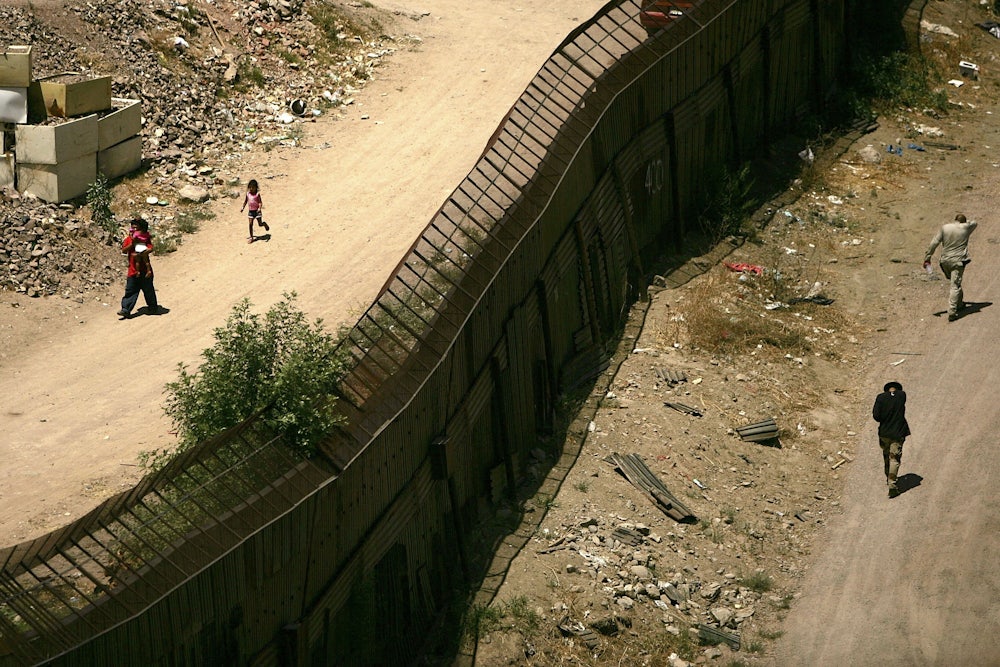Christian Ramirez remembers what life was like before the border wall went up in San Diego. Growing up in San Ysidro, a neighborhood on the city’s southwestern corner, he regularly crossed into Mexico to pick up tacos and bring them back for picnics at Friendship Park, a small coastal area bisected by the border. But after 9/11, new security measures fortified the border wall and extended the barrier into the ocean. “An embrace at that part of the border has been reduced to pinkies touching each other at the border wall,” he said. Now the park, which used to host bi-national religious masses, Christmas celebrations, and family reunions, is locked except for a few hours each weekend, during which federal agents monitor the crowd and people search through the metal grating for a glimpse of a loved one’s face on the other side.
As the director of the Southern Border Communities Coalition, Ramirez works with 60 community organizations to strengthen oversight of U.S. Customs and Border Protection, the federal agency tasked with securing the nation’s borders. And so it was with dismay that he responded to news that a website is hosting a Donald Trump-inspired competition for border wall designs. “The sad reality is that the border region is still viewed as a barren land, with no history, no culture, not inhabited. And that has made this rhetoric of militarization and of iron-fisted policies acceptable as the mainstream narrative of the border region,” he said. “Unfortunately, this sort of contest is right up that alley.”
The competition in question—“Building the Border Wall?”—has stirred up considerable debate since launching in early March. When architectural news website ArchDaily.com posted a call for entries, some wondered whether the competition was a joke. Architect Fabrizio Gallanti called for a boycott of ArchDaily, and demanded the cancelation of the competition itself. Many others, including the architecture competition site Bustler, questioned the ethics of sharing and participating in a competition that seemed to promote xenophobia.
The Third Mind Foundation—a group of “architects, designers, and artists who wish to remain anonymous,” according to its website—is sponsoring the competition. It stated in the original challenge: “Design a barrier of architectural merit that is realistically priced to build and made of materials that will not only be effective in keeping out waves of illegal immigration, but that will also be relatively inexpensive to maintain.” On the jury page, a panel composed of deceased luminaries such as Frida Kahlo, Rosa Parks, John F. Kennedy, and Buckminster Fuller presides, further confusing matters.
Reacting to the criticism, the Third Mind Foundation added the question mark to its competition title and made several changes to the brief. The competition now asks designers “to bring creativity and innovation to bear on the idea of a border barrier.” It also asks, “If not a fence or wall, then what? Can the idea of a wall be combined with architectural activism?” Third Mind also clarified, “We take no position on this issue. We remain politically neutral.”
John Beckmann, a New York-based designer who is the chief organizer of the competition and a liaison for the Third Mind Foundation, was perplexed by the controversy. “Our goal is to create positive humanitarian strategies that propose ideas that move beyond a simplistic binary—build a wall, don’t build a wall, Republican vs. Democrat, United States vs. Mexico—to move to a higher level of discourse here because either notion is very simplistic,” he said. When asked about the controversial language of the original design challenge and the decision to launch the competition without a jury, Beckmann explained that both had been matters of expediency, saying, “We wanted to be the first on this. Second isn’t really interesting.”
Beckmann freely admitted that none of the competition’s organizers had visited the border region or seriously researched the issue in preparation for this competition. “But I don’t think that invalidates the idea or notion that a group of people can propose a competition,” he said. Beyond a list of the technical challenges involved in the construction of such a wall, Third Mind makes no mention of the cities, towns, and communities living along the border.
It takes about three days to walk from the U.S.-Mexico border to Sahuarita, a small town 20 miles south of Tucson, Arizona. When migrants arrive in the town, they knock on residents’ doors, asking for water and other necessities. Residents who want to help call Reverend Randy Mayer, a pastor at the Good Shepherd United Church of Christ. As a co-founder of the Green Valley/Sahuarita Samaritans, he has been doing humanitarian aid work on both sides of the border for decades.

Mayer said, “So much of what we experience is a lot of hysteria that happens inland in the United States, and yet people don’t realize what it’s like down here near the border.” He explained that, contrary to popular opinion, “It’s not filled with crime and it’s not filled with all this destruction and, for the most part, people really value both sides.” After viewing the competition site, he asked, “Instead of building walls and having a competition to build walls, why don’t we put into effect a competition that can build relationships?”
Juanita Molina, executive director of Border Action Network and Humane Borders, a group that tracks border deaths, agreed that architects could put their imaginations to better use. The border wall has not stopped migration, Molina said, only pushed people into the most dangerous, inhospitable areas of the Arizona desert. “To just demonize the people crossing is a very short-sighted view which actually contributes to their invisibility and to the violence,” she said. But then what should architects do, if not design a wall? Molina suggested that since most migrants travel at night and often get lost, architects could help create beacons to safety.
“If you speak to most border residents, the whole idea of this competition kind of misses the point,” said Vicki Gaubeca, the director of the ACLU-New Mexico Regional Center for Border Rights, who lives in Las Cruces, New Mexico. Many people have a misconception that the border is just a line, she said. But within the 100-air-mile enforcement zone given to Customs and Border Protection, Latino and Native American residents are frequently subjected to racial profiling at the many checkpoints far from the actual boundary line. Gaubeca called it a “virtual cage.”
She strongly opposed the notion that the border wall could be made better by design. “Why improve on a bad idea?” she asked. “With all the accoutrements that you want to put on that wall, it’s still a wall, and it’s not a bridge.” Instead, she suggested that architects focus their skills on the colonias, unincorporated border towns that lack infrastructure like roads, potable water, sewers, and dams to protect them from flooding. “It would be great if architects actually got into doing that instead of developing something that could be so damaging to our communities and our environment.”
For Teresa Leal, the director of a small art museum in Nogales, Arizona, the border wall is more than an inconvenience. It divides her tribal lands, separating her people from their sacred sites and burial grounds. As a member of the Opata tribe, she is part of a network of other tribal nations divided by the border, including the Tohono O’odham and Apache nations. “As Indian people, I can tell you this corridor for thousands of years has been our corridor,” she said. In her daily trips to and from sites in Mexico, she must flash her permanent residency card at the border checkpoints, a daily reminder that she is a foreigner in her ancestral land.
As a member of the Border Patrol Victims Network, Leal also supports a dozen families who have lost loved ones to border patrol shootings, several of whom were killed on the Mexican side of the wall. For her, the architectural competition to design a wall is “offensive, ridiculous. … It’s just as if they were trying to design a guillotine, like in the French Revolution.” She urged architects to tell Trump and other politicians who support building the border wall, “‘We can’t be your co-conspirators. We can’t help you to look good. No matter what you build, it’s going to have the same purpose.’”
In the border city of El Paso, Texas, the sense of division feels especially sharp for Guillermo Glenn, who has lived in the border region since 1973. He used to cross the border into Juarez all the time, and remembers the city before NAFTA took effect. People “went to Juarez to celebrate, to cultural events, to the cathedral and the market.” But now, with the long lines at the border crossing and harassment by border patrol, along with the increase in poverty and cartel violence in Juarez, no one wants to go. “Some of the young people don’t even know what Juarez looks like anymore,” he said. Instead, he said, the crossing in El Paso has increasingly come to feel like a segregated passage that privileges the transnational corporations that run the low-wage factories known as maquiladoras in Juarez, while pedestrians and vehicles must wait in long lines under the hot sun.

“Perhaps architects can design really great bridges that take into consideration the great humanity that lives on both sides of the border,” he said. For him, the border, bristling as it is with military personnel and concrete blockades, offers “nothing that would give the idea that you are going into a great country or coming from a great country.” This sentiment was echoed by Christian Ramirez of the Southern Border Communities Coalition: “The indignity of having my grandparents wait in line for two to three hours so they can visit their great grandchild, or having folks standing under the sun and under the rain waiting to enter the U.S.—that’s where we need to really begin putting our talent towards.”
Some architects have been trying to do just that. Charles Dorn, a principal at Hacker Architects, has been designing at the border for 30 years. Hacker’s design for the bus processing station at the Juarez-Lincoln Land Port of Entry in Laredo, Texas, is currently under construction. He relishes the logistical, environmental, and social challenge of designing border crossings.
“I think that the more the ports are symbols of welcoming, the less important the wall becomes,” he said. “But if the ports themselves are intimidating and painful and scary, then the border itself is a lightning rod for attention.”
He considered the border wall design competition provocative, and saw its potential to draw in an immense range of ideas from architects. “From an architectural perspective, they will approach the problem much more compassionately than somebody who looks at it as a technological problem,” he said. However, he added that the concept itself might be fatally flawed: “It could be that the fact that the wall exists in the first place is the reason” the immigration situation is “as bad as it is.”
At Jones Studio, the designers of the new Mariposa Land Port of Entry in Nogales, one of the busiest commercial and cargo truck land ports on the border, were also excited to talk about border crossings. “We set out from the beginning to make the experience one of an oasis, of moving through a beautiful garden,” said Jacob Benyi, a principal at Jones Studio. Their design offers a rare patch of greenery in the desert, with special attention paid to the comfort of pedestrians crossing through on foot and to easing the tensions of border patrol officers. An extensive and colorful shade structure presents the visual of a waving American flag from a distance.

Brian Farling, a lead designer at Jones Studio, considered the border wall a “folly.” But in thinking about the competition, both architects also wondered whether, through design, the wall could be turned on its head, if architects could “come up with a completely different program that exists along the border that somehow benefits both countries.”
However, they would rather work on another border crossing than a wall. “A port is all about people; it’s a threshold, it’s a point of crossing, a point of interaction for commerce, discussion, transit, ideas,” said Benyi. “The wall is the antithesis of that. It’s trying to stop all of those things. It would be a completely different design issue to try and deal with that.”
Other architects who focus primarily on border projects agreed. Ana Martínez Ortega, member of the Tijuana-based multi-disciplinary collective Torolab, wondered what the point of the competition was. “A third wall attempt? A bigger, skinnier, maybe more conceptual wall, really? What else could it bring to the table?” she asked. “The truth is, I don’t even care, and I think none of us ‘border citizens’ do, because it does not create anything that can enhance the border condition.” In contrast, at Torolab’s studio in Camino Verde, an informal, low-income Tijuana neighborhood, the collective holds workshops and programs for migrant residents to foster relationships and generate sustainable income.
Architect, urbanist, and professor Teddy Cruz, who has been working on both sides of the San Diego-Tijuana border for 25 years, presented the competition as a moment in which architects cannot remain neutral. Sometimes, he said, architects must decide when not to build, since “the politics of neutrality has rendered architecture a pure decoration of very unjust policies.”
He added, “Instead of building walls that are dividing communities and dividing environments, we should be looking at border regions as laboratories for rethinking citizenship, for rethinking resilience, for producing new strategies of interdependence and cooperation and co-existence.” This framework is central to his own practice, in which he has designed multi-functional housing informed by the creative building strategies, extended family structures, and cultural life of informal settlements in Tijuana and immigrant neighborhoods in San Diego.
Perhaps there is a broader lesson that can be drawn from the controversy over the border wall. “That wall is reproduced everywhere inside of our American cities,” Cruz said. They might not contain physical walls, but America’s cities are defined by “urban policies that divide jurisdictions and communities” and “an urban asymmetry that has perpetuated socio-economic inequality.” Even places far from the border, it seems, could use some more crossings.
